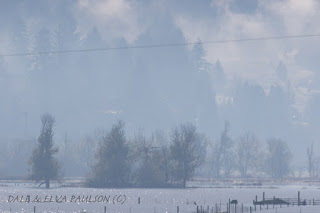I was going to call this blog “Frozen Bird,” but I didn’t
want you to think I was blogging about
dead bird. It’s about being
‘frozen,’ i. e. very, very still.
Have you seen a bird frozen still? It is different from just resting and being
still. There is a relaxed posture when
resting. ‘Frozen’ happens when the bird
is hoping, hoping something isn’t going to see it. Often when I spot a bird on a nest it
freezes. “I’m not here. I’m just part of this lumpy scenery.” Many female birds have dull colors so they
can blend all that much better.
I’ve been watching a ‘frozen’ bird on a twig near my
feeder. I was eating my morning bowl of
hot steel cut oats, blueberries picked last summer, walnuts and yogurt. I look out onto my feeder area. --- Very quiet.
Then I noticed one bird, a frozen house finch. I checked the time; 9:03 AM (lazy start to my
morning!). I finished breakfast: 9:10 AM; and started doing little
chores. I continued to keep an eye on my
bird. By then Dale had pointed out there
were actually two in the bush, two frozen birds.
By now I’m sure there is a hawk in the area -- probably a sharp-shinned
hawk, possibly a Cooper’s hawk. They can
become a real pest at a feeder. One year
I watched a sharpie grab and pluck a pine siskin – a little bird that weights
about as much as a puff of air. It took
him 20 minutes to plunk and eat. I was sketching
by then so I was watching carefully.
When finished, the sharpie popped down into the bushes where another
siskin must have been frozen. More dinner
for the hawk and more sketching for me.
And then the sharpie dropped down and grabbed a third
siskin! Obviously staying frozen doesn’t
always work. It didn’t fool this
hawk. The hawk flew off with the third
bird.
But my best watching-a-frozen-bird sighting had a happier
ending. I was washing dishes and
watching some juncos on my deck.
Suddenly one froze; hanging onto an almost vertical broom handle leaning
on the deck railing. I couldn’t see the
hawk, but I was sure one was perched over the house. The junco was in an awkward position and I
happened to look at the clock -- twenty minutes! Finally he relaxed and flew off.
This morning’s watching had a happy ending too. I don’t know how long the finches had been
frozen when I first noticed one. But it
was 13 minutes before a couple of new birds arrived and started bouncing around
in the bush. The two I’d been watching
relaxed and soon were amongst the flock of birds foraging on the cracked corn
we throw out for them.
By the way, ‘chick scratch’ is excellent food for many of the
ground feeders. Chick starter is too
fine; hen scratch is too coarse for sparrows.
Chick scratch is like coarse corn meal.











